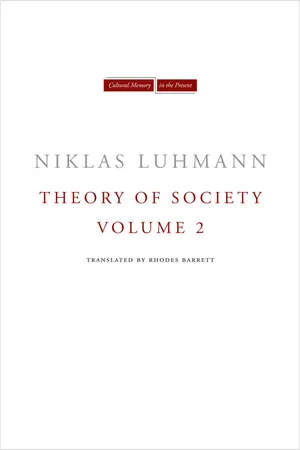![]()
Index to Volume 1
This index is based on the index to the original German edition, Die Gesellschaft der Gesellschaft. Band 1 (Frankfurt am Main: Suhrkamp Verlag, 1997). It is included in Volume 2 as a reference.
Acceptance, 43
Acceptance/rejection, 135, 137, 138–139, 173, 190–191, 277
Accident. See Chance
Action, 45, 180–181, 200–204, 262
Action theory, 14–15, 31, 45
Actuality and potentiality, 21–22, 25–26, 27
Actuality, 23
Adaptation, 55, 262, 265, 268–269, 284, 324, 342
Admiratio, 85, 407n223
Advanced civilizations. See Stratification
Aesthetics, 210
Affected parties, 323
Agreement, 42n109
Agriculture 306–307
Alphabet, 309
Alternatives, 284
Ambiguity, 52, 87
Ambivalence. See Ambiguity
Amplification, 194–195
Anticipatory reactions, 123
Art, 93, 209–211, 231, 290
Art criticism, 225n322
Artificial intelligence, 181
Attribution, 74, 200–204
Authenticity, 101, 143–144, 165–166
Author, 180
Authority, 81, 164, 174, 185, 188, 202
Autology, 1, 11, 26, 31, 78, 83, 104, 110, 118, 330
Autonomy, 29, 59, 134, 224, 236, 245, 298
Autopoiesis, 18, 32–35, 39, 42, 53, 74, 78–79, 103, 183–184, 115, 117, 122, 131–132, 137, 264, 338
Banks, 294
Beautiful/ugly, 29, 227, 338–339
Before/after, 23, 266, 346, 348
Beginning, 267, 358
Beginning and end, 266
Being/non-being, 133, 254, 357
Belatedness, 65, 156
Binary coding, 62, 132–133, 134–138, 215–227, 233, 276–277, 339–341
Blind spot, 110, 118, 258, 326–327
Boundary, 38–39
Causal technology, 217
Causality, 52, 56, 74, 94, 180, 201, 248, 253, 264, 271, 286, 302, 317, 344–345
Censorship, 187
Center/periphery, 283, 295, 301
Chance, 32, 67, 134, 142, 189, 225, 258–259, 263, 265, 270–271, 275–276, 279, 284–285, 303–304, 310, 336–337
Church, 296
Cinema. See Film
Circulation, 234–235
Co-evolution, 325–326, 328, 338
Cognition, 68–73
Coinage, 197, 268, 307
Collective consciousness, 42
Common sense, 549
Communication, 1, 15–16, 34, 35–40, 41–49, 113–249
Comparison, 17, 93–94, 248–249, 355–357
Complexity, 5–6, 77–83, 249, 269–270, 279, 294, 305–312
Complexity, enhancement through reduction, 306
Computer, 66–67, 180–187, 249–250, 320–321
Condensation/confirmation, 38, 82n190
Conditioning, 72, 138, 193
Conditions of possibility, 166
Conflict repression, 280
Conflicts, 190–191, 278, 279–282
Consciousness, 42–43, 44, 51, 56–57, 71n163, 329–330
Consensus, 6, 7–9, 42, 64, 65, 122
Consensus and dissent, 242–243
Conservatism, 293, 299
Consistency, 30, 152, 161, 178, 333
Constructivism, 12, 13, 53n128, 90, 237, 337
Context, 14
Contingency, 25, 79, 82, 86, 95, 126, 282, 334
Contingency formulae, 282
Contract, 213, 308
Contradiction, 286
Corporations, 296–297
Creatio continua, 254
Creation, 11, 18, 85, 101, 251–256, 282, 315
Criteria, 226, 323, 339
Criticism, 5, 13, 109–110, 165, 191, 235, 275, 284, 298, 329
Critique. See Criticism
Crossing, 24, 27, 29, 82, 134, 216, 225, 299
Culture, 87, 94–95, 98–99, 248–249, 324n211, 354–358
Danger, 322–323
Deception, 135
Decisions, 95
Deconstruction, 335
Democracy, 224
Demographic growth, 87
Determinate/indeterminate, 144
Deviation, 273, 282–282
Deviation amplification, 94, 253, 263, 285–286, 345
Dialectic, 335
Dialogue, 172
Différance (Derrida), 38
Differences in rank. See Stratification
Differentiation forms, 294–295, 300–301, 311
Diffusion, 310–311
Digitization, 55, 71, 215
Dissemination media, 120–121, 162, 187–191, 311–312
Dissipative structures, 94, 111
Distinctions, 20–23, 25–35, 161–162, 350–352, 357–358
Disturbance, 321
Divination, 140, 142, 144, 157–158, 170
Divisions into epochs, 255–256, 312, 336. See also Stage models
Dogmatics, 333
Double closure, 40
Double contingency, 127, 199, 201, 239
Duplication rules, 218
Dynamic stability, 23, 118, 160, 260, 297–298, 340
Ecology, 55, 67, 73–77, 108–109, 269, 293, 342
Economy, 337–338, 340–346, 343
Economy/household, 199
Education, 246–247
Eigenbehavior. See Eigenvalues
Eigenvalues, 9, 130, 131, 188, 237
Electronic media, 180–186
Element, 32
Element and relation, 78–79...
